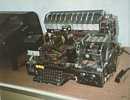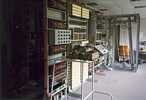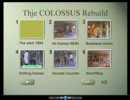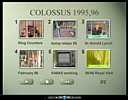Bletchley Park
Summer 1998
Return to Home
On the return trip from Crete (NAMFI Nike Firings) and in London
I decided to visit the famous Bletchley Park, a short train ride north of London :-))
Table of Contents
On the return trip, a side trip to Bletchley Park
Web Sites -
Introduction - added April 18, 2015
Introduction: - added April 18, 2015
The following section describes my visit to the "old" Bletchley Park, when the
restorers and re-constructors were in charge. Around 2003, a new gang took over,
with different goals. Their goals seem to be:
- denigrate all previous accomplishments, - take credit for everything,
- make a pleasant outing for grandma,
- and put up a fence to keep their guests from seeing code breaking history.
- throttle electric power to the volunteers so they have trouble powering their historic computers (below)
(by not permitting an added power line to the restorers).
A reasonable interpretation of their collective actions is to further ride on the backs of
the actual volunteer/worker/restorers. Maybe people like this helped truncate British computing.
Now if you wish to see:
- code breaking history,
- reconstructed code breaking machines, such as Colossus and the bombes,
- as well as some antique British computers, and EDSAC being rebuilt
you
must go to a separate entrance, buy a separate ticket, to see the
The National Museum of Computing
and a great presentation of WWII British code breaking.
Maybe "the gang" has a point - would Gramma be interested in this
?? ;-))
|
Bletchley Park - Summer 1998
On my return trip to the U.S. in the summer of 1998, I land at London and visit
Bletchley Park
The Late Tony Sale's Codes and Ciphers Website
Tony Sales helped lead the efforts I saw :-))
Bletchley Park is where the English broke and read Hitler's messages during World War II.
I call about taking a tour.
Bother, only open every other week end, cannot tour during the week with out a group of
20 or more,
and I am leaving Friday (next available plane after that is the next Tuesday).
Might as well try.
I take the tube to London and British Rail to Milton Keynes (the village containing Bletchley Park).
There are no hotels, so I get a taxi to check the bed&breakfasts.
The 1st six bed and breakfasts are full. Ah - the seventh is available.
|
It is late afternoon. I walk to the guard gate of Bletchley Park,
a friendly guard says there is
a student tour tomorrow (Thursday) and gives me a contact name.
The next morning I show up at the guard gate, ask for contact name - "No - Not possible".
Can I just go to the main building and maybe buy books? "Well - OK, follow me".
I buy over $50 of books and monographs
- fascinating - (I had previously carefully read
David Kahn's "The Codebreakers", sometimes called "the bible". ;-)
Soon the 80 students arrive -
I am made an honorary 10th grader and join a group of 20 students. No problem - some folks
say I have never attained adulthood - this may prove it ;-))
| 
|
The tour guide, John Gallehawk who wrote some of the monographs I had just purchased,
takes this group to a rambling one story wood building, leads the students (and me)
to a class room and we students sit down. John gives us
a great introduction to some of the buzz words of "code breaking" and has good,
large, functional training aids that help get us started. Mirrored writing, reversed words,
various simple transpositions, Cesarean substitution, all within easy reach of
an attentive person. He passes the training aids along with the discussion,
helps individuals with problems - no hurry - just "go with the flow" - enjoy the moment
and the history. John Gallehawk is a great docent/teacher!!
|
He then mentions some of the methods of making more
complex substitutions, and the various problems when you have high volumes
of traffic. Then he moves people to the exhibit of the Enigma machine in the
room and discusses that. Just about everyone stayed in contact with the discussion.
(There is also a very complicated looking suitcase size Lorenz Cipher machine there but
that is well beyond our scope.)
|

|
And soon we are on the "cryptological trail", real radios that caught the German
"coded" messages, real motorcycle that was used to carry "coded" messages to the
code breakers, a real Enigma machine to push the buttons on (and a clear set of
instructions how to set one up to "en-code" a message, or to "un-code" a sample message.
And on and on - Wonderful - John opened a locked door to a room of American items for me,
and I also went into a room describing the difficulties of breaking the code
of the difficult Japanese language. There had been hints that the Poles had
made the early breaks into the Enigma as used by the Germans, but in the 1980's
more information became available of how truly helpful that was. I do not remember seeing
any "bombe" machines used to break the Enigma.
|
More and more.
This is the re-constructed Colossus machine. The originals were used to break the Lorenz machine above.
On and on. I stayed five hours,
left because my head was spinning.
Flash a really understandable presentation of the invention and
operation of the Colossus
here - Computer Conservation Society, Chris Shore, 22 Oct 2015
|

middle
|

front
|
A lot of information accurately clearly understandably presented -
I love to go to English museums.
Books and pamphlets I purchased at Bletchley Park
| The Hut Six Story | Gordon Welchman | 260 pages
| | Alan Turing, the enigma | Andrew Hodges | 580 pages
| | - the following are Bletchley Park Trust Reports | . | .
| The Enigma Machine and the Bombe
| Frank Carter & John Gallehawk | 28 pages
| | Codebreaking with the Colossus Computer
| Frank Carter | 24 pages
| Codebreaking with the Colossus Computer
Finding the K-wheel Patterns ... | Frank Carter | 40 pages
| Codebreaking with the Colossus Computer
An account of the statistical methods ... | Frank Carter | 24 pages
| | Convoys and the U Boats | John Gallehawk | 50 pages
| | Japanese Codes | Sue Jarvis | 32 pages
| | Bletchley Park and the Luftwaffe | Peter Wescombe | 32 pages
| Getting back into "SHARK"
H.M.S. Petard and the George Cross
| Peter Wescombe & John Gallehawk | 20 pages
| | The German Battleships
| Peter Jarvis | 20 pages
|
|
Bletchley Park - disharmony - Feb 2014
Note: According to
the official web site of Bletchley Park,
there was no code breaker's museum as I visited ( above ) in 1998. The current administration
( which took over in 2002 )
claims credit for the whole thing.
Calming down just a bit - consider the word 'parasite'.
*derogatory - "a person who habitually relies on or exploits others and gives nothing in return."
I regard the present rulers of Bletchley Park as parasites - benefiting from, without credit to,
the very successful efforts of the early volunteers. (They have even re-published, under their own banner,
the publications I purchased in 1998.)
|
|
A DVD I purchased from Tony Sale
"Recreating the World War II
COLOSSUS computer
Phase 1 1994 - 1996"
|

| And the two menus
|

|

|
"Anthony Edgar Sale, computer scientist, inventor and museologist, born 30 January 1931; died 29 August 2011"
- obituary in the Guardian
|
Feb 4, 2014,
Oh Look, the BBC reports that the pin-heads
[or whatever]
that run the trust have just fired the volunteers who restored Bletchley Park.
Tony Sale had been made unwelcome at Bletchley Park by the new bosses in 2003,
although he downplayed the event.
The Brits ought to be ashamed of themselves.
But generally volunteers who do the restorations
do usually lose to the the ignorant arrogant pros,
who get control of the property -
OH My Word !!
history of disharmony.
(My interpretation) Hitler isn't dead, he is alive and well - reincarnated as Iain Standen -
and running the Bletchley Park Trust. Apparently he wants to gear the tours to bored old ladies,
and leave out the truly interesting techie code breaking machines and intercept radios
of the period.
I suppose Iain has also thrown out the period motorcycle used to speed the intercepts to
the code breakers.
Maybe his ultimate goal is to turn Bletchley Park into a rose garden ???
|
A proposal to resolve disagreements at Bletchley Park
Posted 22 February 2014 on
http://www.tnmoc.org/news/news-releases/proposal-move-things-forward-bletchley-park
"In view of recent press reports about the disagreements at Bletchley Park, the trustees of The
National Museum of Computing would like it to be known that on 13 February 2014 its Chairman,
Tim Reynolds, wrote to the Chairman of the Bletchley Park Trust, Sir John Scarlett, putting
forward a proposal that an independent and suitably qualified individual (or individuals) be
called upon to review the situation and to work out a way forward that allows the regeneration
of the whole of the historic Bletchley Park Conservation Area. A full reply from the
Bletchley Park Trust is awaited."
12 March 2014 - And another shot in the war.
TNMOC restates call for an Independent Review of Bletchley Park disagreements
August 13, 2014 -As best I can tell, the pig heads running the Bletchley Park Trust are
still being pig headed :-((
Update May 2015, no change :-((
|
And Saving Bletchley Park,
a book about history of Bletchley Park since WWII to 2016
Posted Dec 2, 2016
This is the Amazon.com "Look Inside".
Oddly the "Look Inside" seems to have a different cast of "characters"
involved with Bletchley Park since 2003 than the BBC programs mentioned above.
Maybe the problem is that my view is from the distance of 10,000 Km ??
Posted Dec 7, 2016
Today, Dr. Sue Black, author of Saving Bletchley Park, above, gave a presentation
at the Computer History Museum in MountainView, CA, USA. She discussed how she helped
raise sufficient funds (and continuing support from British government entities)
so that "Bletchley Park is safe".
http://www.savingbletchleypark.org/
After the presentation and book signing, I asked Sue if the Trust (above) vs
The National Museum of Computing
and Computer Conservation Society
had settled their differences and the ugly fence dividing the two parts had come down.
I think she rolled her eyes and then said "If two groups want to fight, there is no stopping them.
I tried, and failed."
(At 10,000 Km distance, I have trouble studying the protagonists.)
|
I want to fly to Britain (with friends) and visit
all on one rail line :-))
|
Wonderful Bletchley Park information from the Internet :-))
Update on Bletchley Park and The National Museum of Computing - from Alan Kay - 2017
|
Well, as Tommy Flowers pointed out at Bletchley Park when he said he could do the Colossus with vacuum tubes, the trick is not to turn them off, and when you do have to turn them on and off do it very slowly. They don't care about the plate EMF. I was told this about vacuum tubes when I was a starving junior high schooler in NYC who couldn't afford new ones (but I didn't learn about Tommy Flowers until years later).
And not that anyone cares any more, but -- for the same reasons -- incandescent light bulbs will last for a long time if they are gradually turned on and off. Similarly, the Alto CRT heaters were more or less on permanently ...
I just visited Bletchley for the fifth or sixth time, and each time they have a lot more to see -- the prime exhibit for some time has been a recreated Bombe. The docent lecture this time was extremely good by a guy (an older gentleman heh heh) who really understood in considerable detail.
There is also on the same grounds but not associated with the Bletchley Park codebreaking museum a small version of the CHM -- The National Museum of Computing -- the most interesting part of which contains serious early computer restorations/recreations.
There is a "Robinson machine" which was the first to have the superfast paper tapes that didn't break.
Robinson | The National Museum of Computing
There is an almost working (recreated) Colossus -- instigated by Max Newman -- it has a lot of vacuum tubes and is a real room warmer.
The Colossus Rebuild | The National Museum of Computing
And the most fun for me is a well towards completion recreation of my favorite early computer: Maurice Wilkes' EDSAC
EDSAC | The National Museum of Computing
-- this is a lovely design -- ca 1948-9 -- and could well claim to be the first actually usable programmed computer (the Manchester Baby just beat it, but it was really a test computer and not practical). It would be wonderful if EDSAC were installed back in Cambridge where Wilkes -- one of the most impressive people in computing I've ever met -- originally built it (and built it quickly). (There is an EDSAC II module at Cambridge from 10 years later.)
The EDSAC I recreation looks just like the photographs (it had about 3000 vacuum tubes), they have a couple of the CRT consoles built (these looked at the stream of bits in the delay lines, and it looks like the last part is to install the mercury delay line tubes in the wooden racks. Lovely! They say "May 2018"!
There is a very good EDSAC emulator online if you'd like to practice for next May!
Cheers
Alan
|
If you have comments or suggestions, Send e-mail
to Ed Thelen
Return to Home
Updated December 8, 2016






